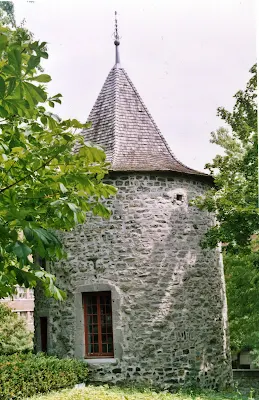
A photograph (above) of Le Grand Seminaire from Sherbrooke Street West and then some photographs (below) taken on the grounds.
Beginning with towers (one is seen above), I think of the Tarot cards, and then the Twin Towers in New York City. There is Joyce's tower in Dublin but, also, Yeats's famous tower; there is Robinson Jeffers' tower and C.G. Jung's tower. There is the poet's tower which is an archetype that exists inside the psyche of every poet.
There is also a long pool of water on the grounds of the Grand Seminaire, overgrown and intimate, with its invitation to dream, to the unconscious, to other pools of water and to water itself, the unconscious mind, a timelessness and place existing beyond space, beyond the here and now but thoroughly involved in the here and now. Water to enter and find, at the ocean's bottom, strange fish from the water's cold depths and perhaps sunken ships and lost treasure.
Doors are entrances, but they are also exits, and they are firmly closed (possibly not opened for many years and next to impossible to open), or left open and busy, part of the mercantile class, or ominous and forbidding, but always archetypal and evoking the unconscious.
Always the invitation to the unconscious is there, that place of poetry and creativity, presented in archetypes, in that which is timeless and gives us hope against the soul deadening efforts of everyday life at the material level. What is life denial? It is existing in the here and now, with no God, no prayer, no meditation, no art, no poetry, no dreams, forsaken of the spiritual... and there are those people in our society with their efforts to eradicate the spiritual by condescension and ridicule and life denial. And then, the presence of archetypes, the unconscious, the mythic dimension. There are the life deniers among us, but no one can ever fully succeed in denying life because, always waiting, like water in a spring (so important to the Celts), are the archetypes, the spiritual, the divine presence, which is always there, always waiting to appear, as natural as fresh water bubbling up from a spring on the side of a road. And what is as natural as water from a spring? It is that the unconscious mind is seemingly hidden but always present, always showing itself in dreams and archetypal dream imagery or strange complex behaviour only explainable by psychology.
The unconscious is present, it is always "behind the scenes" so that life is not as we might rationally want, but as the unconscious decides in its own way, almost a separate entity with its own rules and, importantly, always moving towards psychic wholeness, psychic healing.
You ignore the unconscious at your own peril. The archetypes are portals into the unconscious, into poetry.
Revised: 31 March 2020; this is substantially the same commentary as when it was originally published; I have edited a few sentences, included paragraph breaks, and so on; some of this is no longer what I would write today.
In the name of making money and nothing else, what you see in these photographs no longer exists.














